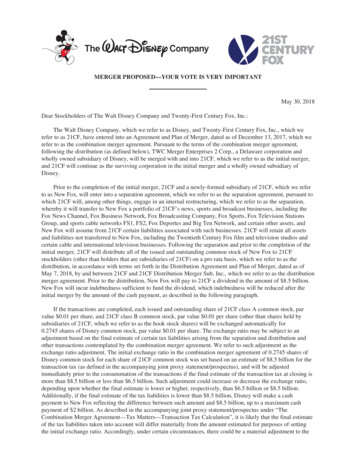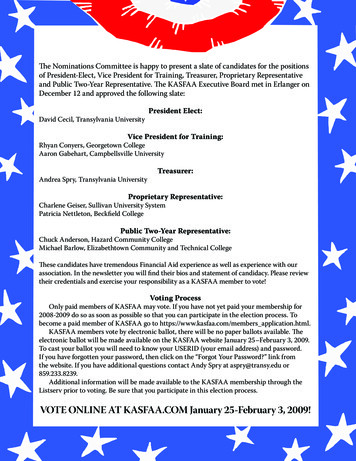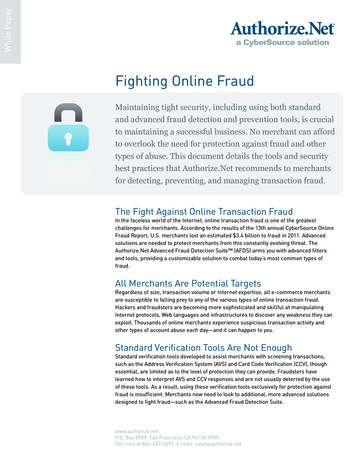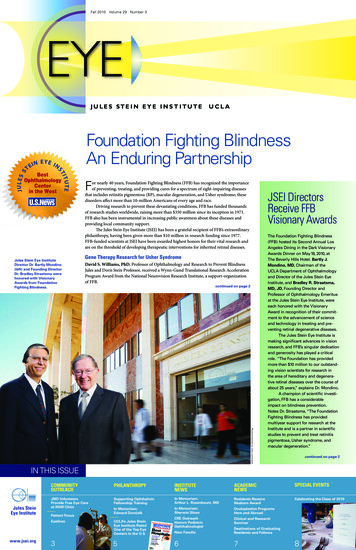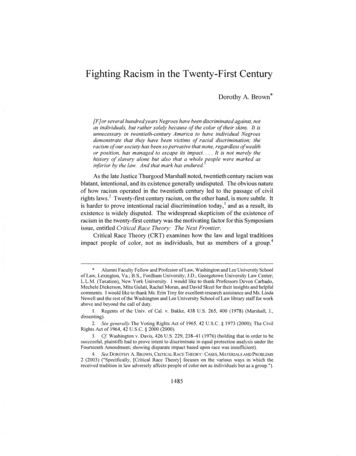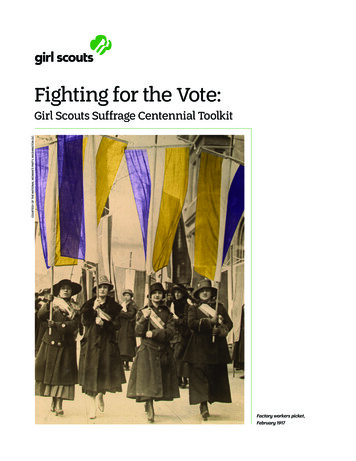
Transcription
Fighting for the Vote:COURTESY OF THE NATIONAL WOMAN’S PARTY, WASHINGTON D.C.Girl Scouts Suffrage Centennial ToolkitFactory workers picket,February 1917
Table of ContentsThe Girl Scouts Suffrage Centennial Patch Program. . 3An Overview of Women’s Voting Rights in America. 4A Gallery of Activists. . . 10Fast Facts About Suffrage. . 13Women’s Suffrage Reading List. . . 14Resources. 16Glossary. . 19Earn Your Suffrage Centennial Patch:A Guide for Daisies, Brownies, and JuniorsEarn Your Suffrage Centennial Patch:A Guide for Cadettes, Seniors, and AmbassadorsFun Art Projects About SuffrageTake Action Now: The Nineteenth AmendmentCentennial Coin Project 2020 Girl Scouts of the United States of America. All rights reserved.No part of this publication may be reproduced, distributed, or transmitted in any form or by anymeans, electronic or mechanical methods, including photocopying, recording, or by any informationstorage or retrieval system, now known or hereinafter invented, without the prior written permissionof Girl Scouts of the United States of America (GSUSA), except in the case of brief quotations embodiedin critical reviews and certain other noncommercial uses permitted by copyright law. For permissionsrequests, write to GSUSA at the address below or visit the www.girlscouts.org website to accesspermission request forms.Links to third-party websites are provided for convenience only. GSUSA does not endorse nor supportthe content of third-party links and is not responsible for the content or accuracy, availability, orprivacy/security practices of other websites, and/or services or goods that may be linked to oradvertised on such third-party websites. By clicking on a third-party link, you will leave the currentGSUSA site whereby policies of such third-party link may differ from those of GSUSA.First published in 2020 by Girl Scouts of the United States of America420 Fifth Avenue, New York, NY 10018-2798www.girlscouts.orgGSUSA recognizesand appreciates thelocal council efforts torecognize the importanceof voting rights and civicengagement through theirindividual activity guides.
The Girl Scout SuffrageCentennial Patch ProgramThe Girl Scout Suffrage Centennial Patch Program gives your troop a chance toexplore the history of voting and women through lots of great information and funactivities. The materials and activities in this toolkit are provided to prompt girlsto discover the history of women’s voting rights and civic engagement, connectand have multigenerational conversations within their communities, and betterunderstand the gender barriers that have been broken and celebrate the womenwho broke them. Ultimately, this will reaffirm Girl Scouts’ civic purpose, strengthenthe future impact of girls’ advocacy, and inspire girls to create projects that sharetheir experiences with others and to take action in their own communities.Order your Suffrage Centennialpatch once you complete thepatch requirements and wear itproudly!Historic narratives, biographies of suffragists, online resources and exhibits, atimeline of suffrage milestones, and a glossary of terms are also included toprovide background information that will enhance girls’ experience during thecentennial of suffrage in 2020.19th Amendment to the ConstitutionThe right of citizens of the United States to vote shall not bedenied or abridged by the United States or by any State onaccount of sex.On June 10, 1919, Michigan andWisconsin were the first statesto ratify the 19th Amendment.The last state to ratify wasMississippi, in 1984.Congress shall have power to enforce this article byappropriate legislation.Suffrage Centennial Toolkit3
An Overview of Women’sVoting Rights in AmericaDid you know that it’s only been 100 years since the United States Constitutionrecognized voting as a right for women? Before the Nineteenth Amendmentgranted women the right to vote, they struggled to achieve the rights of fullcitizenship. The suffrage movement was the first time women across our nationorganized to publicly demand the same voting rights and privileges as men.When you open a dictionary and look up the word suffrage, you will find that itmeans the right to vote. Our country is a democracy, identified by the phrase “oneperson, one vote,” but the early framework of our government did not give the rightto vote to everyone.Who Voted in Early America?In 1776, Abigail Adams urged her husband John to “remember the ladies” whenthe Continental Congress was discussing who should have the right to vote.Unfortunately, when the U.S. Constitution was drafted in Philadelphia in 1787,participation in this new democracy included only white men who met thereligious, property, and tax-paying criteria. It called for each state to determinewho would be allowed to vote. For a time, women in New York, Massachusetts,New Hampshire, and New Jersey could vote, but by 1807, all four states had revokedvoting rights for women.LIBRARY OF CONGRESS PRINTS AND PHOTOGRAPHS DIVISIONThis changed in 1869, when the Wyoming Territory legislature granted womenthe rights to vote and hold public office. Almost 30 years later, women in Colorado,Utah, and Idaho had also won voting rights. Between 1910 and the passageof the Nineteenth Amendment in 1919, women gained the right tovote in eighteen more states, but most American women were stilldisenfranchised. That changed in August 1920 when Tennessee becamethe 36th state to ratify the amendment granting women the right to voteand the Nineteenth Amendment became law. It had taken 133 years forthe U.S. Constitution to grant women the same voting rights and privilegesas men.Elizabeth Cady Stanton, seated,and Susan B. Anthony, standing,were friends who worked side byside for decades on suffrage andwomen’s rights issues.The Early Suffrage MovementIn 1848, early in the suffrage movement, many women gathered in SenecaFalls, New York, to demand changes to the social, legal, and educationalrules that hindered women from achieving economic equality andthe right to vote. After the Civil War, the passage of the FourteenthAmendment gave voting rights to all male citizens over the age of 21.And the Fifteenth Amendment strengthened voting rights for citizensregardless of race, color, or previous condition of servitude, explicitlygiving voting rights to black men and former slaves, but not to women.Suffrage Centennial Toolkit4
COURTESY OF THE NATIONAL WOMAN’S PARTY, WASHINGTON D.C.The official campaign to extend voting rights to women began in Seneca Fallsand ended with the ratification of the Nineteenth Amendment in 1920. Today,women’s participation in politics and civic engagement is expected, but backthen both men and women worked to suppress women’s right to vote. Somebelieved that women should focus solely on their husband and children, whileothers thought that women could not understand politics or that having their ownopinions was unladylike.Above: Is the “Women’s Rights”button pro or con? This antisuffrage button warned thatempowered women would dounladylike things such as baringtheir ankles.Left: Suffragists picketed outsidethe White House with bannersasking the President to supportsuffrage.The Young Are at the GatesBy 1912 founders of the suffrage movement, including Elizabeth Cady Stanton,Susan B. Anthony, Sojourner Truth, and Lucretia Mott, had passed away. The boldyounger women who followed them began to use tactics and strategies employedby the British suffragettes, such as protesting the government and publiclydemanding their right to vote. Many were arrested and sent to jail for their actions.Two young American women, Alice Paul and Lucy Burns, met after they wereboth arrested for protesting in England. Once back in America, they used thesame protest methods. They sewed large banners emblazoned with brash rallyingcries, such as “The Young Are At The Gates” and “Mr. President What Will You DoFor Woman Suffrage.” They carried the banners in parades and protested in frontof the White House gates. While the public and many fellow suffragists did notapprove of their actions, they did get results.Suffrage Centennial Toolkit5COURTESY OF THE ANN LEWIS AND MIKE SPONDER WOMEN’S SUFFRAGE COLLECTIONAnti-Suffrage
From Action to VictoryCOURTESY OF THE NATIONAL WOMAN’S PARTY, WASHINGTON D.C.Between 1913 and 1919 women across the country marched in local parades andcarried banners demanding the right to vote. They launched extensive letterwriting campaigns to their state legislators and to newspapers, to educate thepublic about suffrage and gain the support of male voters. In Washington, DC, whensuffragists increased their protests in front of the White House, police arrestedthem on charges of disturbing the peace and blocking the sidewalk. The womenwere sent to the District of Columbia jail or the Occoquan Workhouse in Virginia,where they were kept in squalid conditions. Many protested by going on hungerstrikes and were then force-fed by the prison doctors. When the public found outabout their brutal treatment, many were outraged and began to support suffrage.SuffrageTimelineNational Park eline-1648-to-2016.htmWant to know more aboutthe history of women’svoting rights? Follow thislink for a comprehensivetimeline going backto 1648! It includesinformation on failed andsuccessful attempts atchanges in law, including atthe state and federal levels,on how women’s suffragehas been interlaced withquests for other civil rights,and on some key courtcases. It spans the yearsfrom 1648, when MargaretBrent demanded but wasdenied a vote in Maryland’scolonial assembly, through2016, when Belmont-PaulWomen’s Equality NationalMonument was designated.When the prisoners were releasedfrom the Occoquan Workhouse,they went on a nationwidespeaking tour called the “PrisonSpecial” to raise awareness.Suffrage Centennial Toolkit6
Girl Scouts and the Suffrage MovementOn a personal level, there were women such as EdithCarpenter Macy and Sarah Birdsall Otis Edey who werenot only key leaders in the Girl Scout Movement, theywere also suffragists actively working for the cause. Macy,Chair of the Executive Committee of the National Boardfrom 1919–1925, was active in the League of WomenVoters, and Edey hosted suffrage events in her New Yorkhome. After the passage of women’s suffrage in 1920,girls across the country cared for infants and childrennear polling stations so their mothers could exercise theirnew right to vote in political elections. They wore therecognizable and familiar Girl Scout uniform and were awelcome sight for both mothers and fathers, who eagerly handed children over tothe girls while they went inside to cast their votes.Today, we continue Juliette’s work by engaging in multi-generational conversationsto broaden the understanding of suffrage achievements while renewing ourcommitment to civic purpose and girl’s advocacy.GSUSAIn 1912 Juliette called her cousin Nina Pape andexclaimed “I’ve got something for the girls of Savannah,and all America, and all the world, and we’re going tostart to-night.” From that time forward Juliette used herconsiderable energy to build a movement centeredaround girls being of service to their country. As the fightfor suffrage continued, the public viewed it largely as apolitical fight. Girl Scouts agreed, and did not formallysupport suffrage, seeing it as a political cause.In 1920 Girl Scouts across thecountry cared for children outsidepolling places while their mothers(and fathers) went to vote.Yellow RosesGSUSABoth Girl Scouts and Suffragists have a special history the yellowrose. Suffragists relied heavily on images, colors, and cartoons toenhance their message of “Votes for Women.” Those who were prosuffrage proudly wore a yellow rose to show their support, whileanti-suffragists wore a red rose. In the final days of the push forratification in Nashville, Tennessee, the local media dubbed it “thewar of the roses.”Did you know that both Girl Scouts and thesuffrage movement used the yellow roseas a symbol? There is even a rose namedspecifically for Girl Scouts!The Girl Scout rose, a yellow Floribunda, was introduced in thefall of 1960 at the triennial convention in anticipation of the 50thbirthday celebration on March 12, 1962. “Blossoms for the BirthdayYears,” as the Girl Scout celebration was called, promoted plantingGirl Scout roses or, if roses were not suited to the climate, any otheryellow flower, in order to celebrate the 50th anniversary.Suffrage Centennial Toolkit7
When Were Women of Color Granted the Vote?When the Nineteenth Amendment was ratified in 1920, it lifted the genderrestriction on voting and should have allowed all women to vote. Indeed, in thoseearly years, African-American women voted in elections and even held politicaloffice. However, many states then passed laws discriminating against AfricanAmericans, limiting their rights by enacting poll taxes and literacy tests or throughthreats, intimidation, and outright physical violence. Nevertheless, AfricanAmerican women continued to fight for their rights. Educator and political advisorMary McLeod Bethune formed the National Council of Negro Women in 1935 topursue civil rights. Tens of thousands of African-Americans worked over manydecades to ban racial discrimination in voting, which was finally achieved whenthe Voting Rights Act passed in 1965.Women of color, including immigrants, indigenous people, and Hispanic women,all waited decades longer than white women to be enfranchised and allowed tocast their votes unimpeded. Even the passage of the Indian Citizenship Act of 1924did not give most nonwhite Hispanic and indigenous people the right to vote. Forsome, voting rights didn’t come until the 1950s, and in some rural areas, even later.COURTESY OF THE ANN LEWIS AND MIKE SPONDER WOMEN’S SUFFRAGE COLLECTIONAnti-Slavery and SuffrageIn 1807, the Slave Trade Act abolished the transport of slaves from Africa. Thisaction inspired many religious communities such as the Quakers to workin the abolition movement to rid America of slavery. In 1832, free AfricanAmerican women organized the first entirely female abolitionist group,called the Salem Female Anti-Slavery Society. Within the next several years,other organizations were formed by white women primarily from antislaverysocieties in northern states. Susan B. Anthony, Eleanor Cady Stanton, LucretiaMott, and many others worked to end slavery and ensure voting rights forwomen. In 1838, Sara Moore Grimké published the pamphlet Letters on theEquality of the Sexes and the Condition of Women, calling for greater genderequity and especially for women to have the right to vote. She, along with hersister, Angelina Grimké Weld, regularly lectured on abolition and women’srights. In 1858, Sojourner Truth delivered her famous “I Am as Strong as AnyMan” speech in Akron, Ohio. Born into slavery in New York in 1797, Truthbecame an itinerant preacher lecturing widely on abolitionism and suffrage.Ultimately, the 1861 outbreak of the Civil War ushered in the passage of theThirteenth Amendment outlawing slavery. In 1870, the Fifteenth Amendment gave African American men theright to vote.During the nineteenth and twentieth centuries, African American women played an active role in the strugglefor universal suffrage. However, despite their hard work, organizations were often segregated along racial lines.For example, the National American Woman Suffrage Association (NAWSA) prevented them from attendingtheir conventions, and organizers of the 1913 Suffrage Procession held in Washington, DC, instructed them tomarch in the back. In reality, African American women played an important role in getting the Fifteenth andNineteenth Amendments passed, as well as the Civil Rights Act of 1964 and the Voting Rights Act of 1965.Suffrage Centennial Toolkit8
GSUSAA Commitment to CommunityService and Civic EducationBy 1918, the U.S. had entered World War I, andGirl Scouts continued their community serviceby providing support for the war effort by sellingwar bonds, rolling bandages, and growing theirown food. When the Spanish flu pandemic struckthat same year, they volunteered in hospitals. TheHow Girls Can Help Their Country,introduction of a Civics badge was a natural fit withthe first Girl Scout handbook,their activities. To earn the badge, girls learned aboutpublished in 1913the government as it affected their everyday lives:how officials at the federal, state, and local levels were elected and what servicesthey provided. They also learned about the requirements to vote, the purpose of theDeclaration of Independence, and important points of interest in their own city ortown.GSUSATwo years before women in America even hadthe right to vote, Girl Scouts created the first Civicsbadge! Created in 1918, Juliette Gordon Low knewthat community service was a key value of GirlScouting. The first handbook was called How GirlsCan Help Their Country and included sections on“Hospital Work” and “Patriotism.”Girl Scout Civics badge, 1918During the next two years, suffragists actively pursued the vote. The NineteenthAmendment was drafted, approved by Congress, and sent to the states forratification. That same year, Girl Scouts rolled out a new badge to replace the Civicsbadge: the Citizens badge. It incorporated many of the same requirements of theCivics badge, but with some new twists: How do laws get made in your state? Towhom in government would you go if you needed help for a child who is not inschool or a break in the water main in the street? What political party would youjoin, and why? What can you do to improve the government of your community?The badge had moved from being one that encouraged girls to understand theworld they lived in to one that encouraged girls to actively participate in changingthe world they lived in—for the better. The Citizen badges are STILL importantbadges for girls in 2020, as are the brand new Civics badges!Earn (and Learn) More!The National Park Service and GSUSA are co-sponsoring the Girl ScoutRanger 19th Amendment Patch Program, which can be found here.If you are interested in exploring suffrage further, completing the GirlScout Ranger 19th Amendment Patch is a great way to do it!Suffrage Centennial Toolkit9
LIBRARY OF CONGRESS PRINTS AND PHOTOGRAPHS DIVISIONCarrie Chapman Catt becameinvolved in the suffrage movementin the late 1880s and eventuallybecame the president of theNational American WomanSuffrage Association (NAWSA).She devised the “Winning Plan,”which carefully coordinated statesuffrage campaigns with the drivefor a constitutional amendment.After the 19th Amendment wasratified, Catt founded the League ofWomen Voters to educate womenon political issues and served as itshonorary president until her deathin 1947.COURTESY OF THE NATIONAL WOMAN’S PARTY, WASHINGTON D.C.FROM EXHIBIT CHRONICLING AMERICA, NATIONAL FOR THE HUMANITIES AND THE LIBRARY OF CONGRESSLIBRARY OF CONGRESS PRINTS AND PHOTOGRAPHS DIVISIONA Gallery of ActivistsAlice Paul sewed the final star on theratification flag after Tennessee became the36th state to ratify the 19th Amendment.Mabel Ping-Hua Lee was aChinese woman raised in New YorkCity who fought for women’s right tovote, riding in a 1912 pro-suffrageparade on horseback. Becausethe Chinese Exclusion Act barredChinese immigrants from theprocess of naturalization until 1943,the passage of the right to vote hadno effect on her personal ability tovote. She was the first woman tograduate from Columbia Universitywith a Ph.D. (in economics).Alice Paul joined women’s suffrageefforts in England while studyingthere. On returning to the UnitedStates, she became active in theU.S. suffrage movement, lobbyingCongress for a constitutionalamendment and organizingprotests, including the famousparade prior to Woodrow Wilson’sfirst inauguration. She joinedover 1,000 others in picketing theWhite House for 18 months. Afterthe 19th Amendment was ratified,she devoted herself to equal rightsfor women, authoring the EqualRights Amendment (which hasstill not become a constitutionalamendment).Mary Church Terrell was one of the first African American women toearn a college degree. She became known as a national activist for civilrights and suffrage, helping found the National Association of ColoredWomen (NACW) and serving as its first president. She was also one ofthe founders of the National Association for the Advancement of ColoredPeople (NAACP). She fought for woman suffrage and civil rights becauseshe realized that she belonged “to the only group in this country that hastwo such huge obstacles to surmount both sex and race.”Suffrage Centennial Toolkit10
NATIONAL PORTRAIT GALLERY, SMITHSONIAN INSTITUTIONNATIONAL PORTRAIT GALLERY, SMITHSONIAN INSTITUTIONLIBRARY OF CONGRESS PRINTS AND PHOTOGRAPHS DIVISIONSojourner Truth, born into slaveryin New York state and namedIsabella Baumfree, escaped tofreedom in 1826. In her mid-forties,she became a Methodist andchanged her name to SojournerTruth. She began speaking aroundthe country against slavery and forequal rights for both women andblacks. Her memoirs, Narrative ofSojourner Truth, a Northern Slave,were published in 1850. She spokeat the Second Annual Conventionof the American Woman SuffrageAssociation in 1871.Ida B. Wells-Barnett was borninto slavery during the Civil War.She became a teacher and thena journalist (she co-owned thenewspaper she wrote for). Shedocumented lynching in theUnited States in the 1890s andfought against racism as well asfor women’s suffrage, believingthat enfranchisement was a wayfor black women to influencepolitics. She helped found theAlpha Suffrage Club in Chicago,which played a significant role inelecting the first African Americanalderman in Chicago.Zitkála-Sá (Lakota for Red Bird orCardinal) was a Yankton DakotaSioux writer and political activistwho was later known as GertrudeSimmons Bonnin. She wascofounder of the National Councilof American Indians, established tolobby for Native people’s right to fullcitizenship through suffrage. Shewas also active in the 1920s in themovement for women’s rights. Shecontinued to work for civil rightsand better access to health care andeducation for Native Americansuntil her death in 1938.Suffrage Centennial Toolkit11
GSUSASuffragists Associated withthe Girl Scout MovementBirdsall Otis Edey and Girl Scouts at the Rally in Central Park, NewYork, 1920. As a major supporter of both Girl Scouts and the suffragemovement, she often hosted suffrage events at her home.(Sarah) Birdsall “Bird” Otis Edey served the GirlScouts in a variety of roles, beginning as captainof a troop in Bellport, New York, and finishingas national president of the Girl Scouts of theUSA (GSUSA) from 1930-1935. In 1935, she wasnamed National Commissioner, an office createdespecially for her, in which she served until herdeath in 1940. Edey was an active participant inthe suffrage movement as early as 1916, servingas an officer in various suffrage organizationsand hosting suffrage-related events at her homeon Long Island. After women acquired the vote inNew York, Edey served as chair of the intelligencecommittee of the New York State League ofWomen Voters. Indeed, her work with the GirlScouts convinced her that scouting “offeredpreparation for citizenship.”Edith Wiseman Carpenter Macy chaired the Girl Scouts National Executive Boardfrom 1919 until her unexpected death in 1925. Juliette Gordon Low called her “anevenly balanced woman” who “really was the pivot that kept our whole organization inharmony.” She founded the Westchester County Girl Scout Council and was well knownfor her extensive charity work. Active in suffrage and later in the League for WomenVoters, her husband shared her progressive views. In her memory, he donated 200acres and 100,000 toward what became the Edith Macy Conference Center in BriarcliffManor, New York, which still hosts Girl Scout training programs today.Helen Storrow came from a family heavily involved in social reform. Her mother was vice president of theNew York State Woman’s Suffrage Association and her aunt was Lucretia Mott, the abolitionist. She becameinvolved with Girl Scouts when she began the First National Girl Scout Leaders’ Training Program at herMassachusetts summer home. She served as first vice president of the national organization and eventuallychaired the World Committee of the World Association of Girl Guides and Girl Scouts (WAGGGS). As chair of theEastern States Exhibition’s “Home Department”, she included in the exhibit a room dedicated to the process ofvoting, wanting all women to feel at ease with the voting booth once the 19th Amendment was passed into law.Mamie George S. Williams is best known as the first African-American woman appointed to the RepublicanNational Committee as well as the first woman to speak on the floor of the Republican National Convention thatyear (1920). Her civic involvement began during WWI with the Red Cross and Liberty Loan drives but movedinto politics after the passage of the 19th Amendment. She fought relentlessly to get African-American womenin Georgia registered to vote in the 1920 presidential election. Williams was one of the early African-AmericanGirl Scout troop leaders in her hometown of Savannah, eventually having a troop named after her.Suffrage Centennial Toolkit12
Fast Facts About SuffrageFast Fact: The term “suffragette” began in England and was a derogatory termcoined by the press. Instead of letting it diminish their efforts, the women adoptedthe term and continued to use it throughout their campaign. American womenlargely self-identified as “suffragists,” so that’s still how we refer to them today.Q: Did men or womenoppose women gainingthe right to vote?Fast Fact: Both men and women joined antisuffrage organizations. Called “antis,” these groupsopposed voting rights for women for manyinaccurate reasons, including that women weretoo sensitive to vote, thatwomen might neglect theirPostcardswere used bychildren and husbands if theyboth suffragetook time to vote, and thatsupporters andif women were involved inanti-suffragists.politics they would becomeDo you think this“coarse” and would no longeris for or againstbe the “gentler sex.”suffrage?Q: Did the 19thAmendment give allAmerican women theright to vote in 1920?Fast Fact: The amendment removed thegender restriction to voting, which should haveenabled all American women to vote. Theamendment states “The right of citizens of theUnited States to vote shall not be deniedor abridged by the United States or byany State on account of sex.” However,many women (and men) of color weredenied the right to vote through physicalviolence and racially restrictive lawssuch as poll taxes and literacy tests.Q: Were all suffrageorganizations raciallysegregated?Fast Fact: No. Some organizations wereintegrated, and their members workedtogether for universal suffrage andwomen’s rights. Other organizations weresegregated and advocated for voting rightsthat were for educated whites only.Q: Did Suffragists use thecat or the dog as a symbolto represent their work toachieve voting rights?Fast Fact: Anti-suffrage organizations inEngland claimed that a woman voting wasas ridiculous as a cat voting. Suffragistsaround the world then began to useimages of cats in their publications as theydemanded their right to vote, and SuffrageCat was born!POSTCARDS AND BUTTON COURTQ: Didn’t Americanwomen call themselves“suffragettes?”ESY OF THE ANN LEWIS AND MIKESPONDER WOMEN’S SUFFRAGE COLLECTIONSuffrage Centennial Toolkit13
Women’s Suffrage Reading ListFor Adult Readers:Adams, Katherine H. and Michael L. Keene. After the Vote Was Won: The LaterAchievements of Fifteen Suffragists. McFarland & Company Publishers, 2010.COURTESY OF THE ANN LEWIS AND MIKE SPONDER WOMEN’S SUFFRAGE COLLECTIONCooney Jr., Robert P.J. Winning the Vote: The Triumph of the American WomanSuffrage Movement. American Graphic Press, 2005.Want to learn more?Here are somebooks and articlesto give you moreinformation!Dudden, Faye E. Fighting Chance: The Struggle Over Woman Suffrage and BlackSuffrage in Reconstruction America. New York: Oxford, 2011.Giddings, Paula J. Ida: A Sword Among Lions. New York: HarperCollins, 2009.Gordon, Ann D., and Bettye Collier-Thomas, Eds. African American Womenand the Vote 1837-1965. Amherst: University of Massachusetts Press, 1997.Painter, Nell Irvin. Sojourner Truth: A Live, A Symbol. New York: W. W. Nortonand Company, 1997.Schuyler, Lorraine Gates. The Weight of Their Votes: Southern Women andPolitical Leverage in the 1920s. Chapel Hill: University of North Carolina Press, 2006.Terborg-Penn, Rosalyn. African American Women in the Struggle for the Vote,1850-1920. Indiana University Press, 1998.Tetrault, Lisa. The Myth of Seneca Falls: Memory and the Women’s SuffrageMovement. Chapel Hill: University of North Carolina Press, 2014.Weiss, Elaine. The Woman’s Hour: The Great Fight to Win the Vote. Viking Press,2018.Wheeler, Marjorie Spruill. Votes for Women! The Woman Suffrage Movement inTennessee, the South, and the Nation. Knoxville: University of Tennessee Press,1995.Suffrage Centennial Toolkit14
COURTESY OF THE NATIONAL WOMAN’S PARTY, WASHINGTON D.C.BUTTON COURTESY OF THE ANN LEWIS AND MIKE SPONDER WOMEN’S SUFFRAGE COLLECTIONGirls teamed up to sell theSuffragist newspaper to raisemoney for the campaign.For Younger ReadersBausman, Ann. With Courage and Cloth: Winning the Fight for a Woman’s Right toVoteBlumenthal, Karen. Let Me Play: The Story of Title IX: The Law That Changed theFuture of Girls in AmericaChin-Lee, Cynthia, and Halsey, Megan. Amelia to Zora: Twenty-Six Women Wh
The Girl Scout Suffrage Centennial Patch Program gives your troop a chance to explore the history of voting and women through lots of great information and fun activities. The materials and activities in this toolkit are provided to prompt girls . but most American women were still disenf

